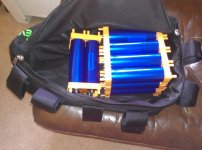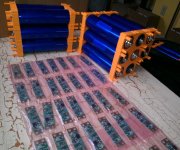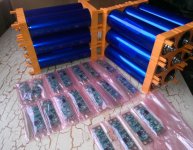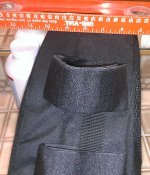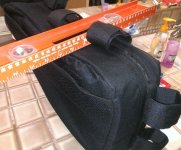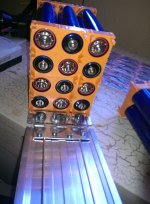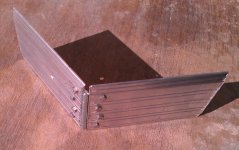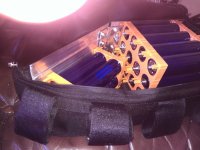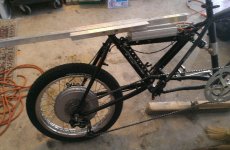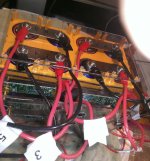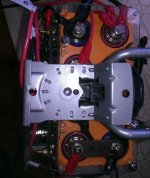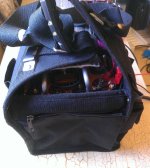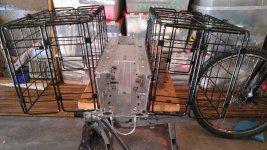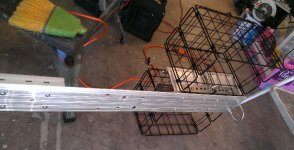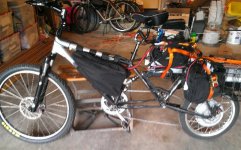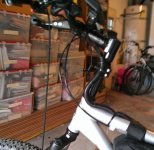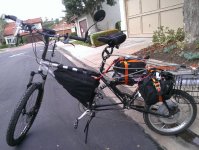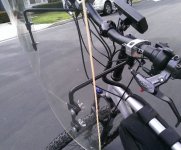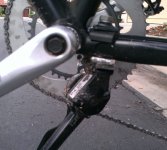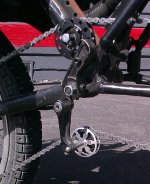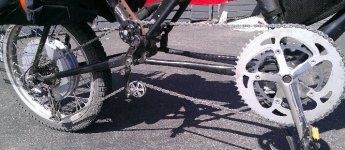

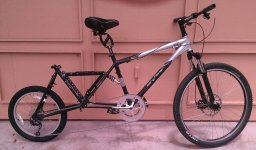 View attachment 5View attachment 4
View attachment 5View attachment 4
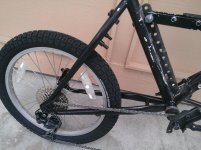
First, let me apologize for being unable to control which photos are inbedded, which photos require opening by the reader, and the location of these photos.
With advice from many on these forums I'm into my second build with a full suspension hubmotor cargo bike that is designed to carry my 260# 66 year old body plus cargo up and down steep omnipresent SoCal coastal hills without overheating.
The bike is pictured as it now stands before adding electrical items, a chain drive-side idler, extending rear derailleur and brake cables etc.
Main frame is a 2007 Gary Fisher 26" Big Sur Hardtail size 19". Fork is an inexpensive but reasonably solid Rockshox XC 32TK 29er with a BB7 203mm disc brake and a 2.1" tire.
Rear triangle with down tube and top tube stubs is a fairly heavy chromoly Giant 26" ATX 770 small 16" frame from 1993. Following Spinning Magnet's lead I've connected the frames at the GF rear dropout and the Giant BB. I built up a simple threaded 10mm rod to fit a fairly standard BB so I could attach with nuts on the outside of the dropouts. I then built an adjustable reinforced strut assembly from 1/4" by 1" aluminum bars reinforced with aluminum tubing. The strut assembly connects to a spring that is removably attached to the GF seat tube with a 3" long load-spreading stainless steel pipe leak repair clamp with integrated rubber cushioning between the stainless steel and the down tube.
The strut is attached at the top to a welded-on 1/4" by 1" steel bar with holes at 1" spacings that I repurposed from unused extra mounting parts from a garage door motor assembly. I'll use one of the lower holes to mount a chain guide that eliminates chain interference with the axle mount in the GF rear dropout.
The rear wheel will have an HT3525 hub mounted into a relatively light 2.4# 16" * 1.6" alloy motorbike rim. I drop shipped the rim to Ilia Brouk at eBikesSF who did the very nice single cross lacing with Phil Woods 12 Ga spokes. I'll initially run the relatively heavy 29 oz. Subrosa Gravedigger 20" x 2.3" BMX tire in back until and unless I see the need to replace with a motorbike tire that could weigh as much as 8#. (Until I mount the HT3525 wheel I'm using an old 20" wheel with a 9 cog 11-34t freewheel that fits in the appropriately spread-out Giant rear dropout.)
The larger chainwheel is a 60t Vuelta which required both (a) the use of a 153mm wide BB recommended by Chalo to eliminate chainwheel interference with the GF right chainstay and (b) offset-mounting the Giant 113mm wide BB all the way to the left side of the 135mm wide GF rear dropout to keep the chain from bending against the same GF chainstay.
I'll be driving the HT3525 with a Lyen 18 FET 4115 controller powered by 20 AH 32S LiFEPo4 cells which appear to be able to get me to 36mph on flat ground at WOT. Ilia is installing a POT in the 200V CA which will allow me to infinitely adjust the current below the 45A Lyen default. Regen is enabled and will be activated with the rear ebrake handle. I'll set up the Crystalyte cruise control and an on-off toggle switch for regen for use if the motor overheats going downhill.
The 104V 20AH battery pack will be built from less expensive 2A continuous load and 3A max load rated cells because the relatively higher voltage pack will pull proportionately fewer battery amps for the 2 kW to 3kW max loads I intend to use for acceleration and hill climbing. I expect to mount 8 cells in the front triangle, 8 cells below the strut in and below the GF rear triangle, and 16 cells in and around the strut assembly.
I should also be able to mount a pair of Wald foldable 12.5" long by 7.5" wide by 8.5" tall baskets over and mostly in front of the rear wheel for cargo. Heavy cargo should be accomodated with BOB Nutz mounted in the rear dropout area for my BOB trailer.
BTW, when towing the BOB trailer I believe that I qualify for riding a "3 wheeled device" up to 30 mph legally as a senior citizen pursuant to section 407 of the California Motor Vehicle Code.
Since the CA V3 beta units aren't available now I'm having Ilya set up a temp display that should mount on my 130mm stem just below the CA.
I don't think that the rear suspension should cause the main BB to drop more than 2". Since the bike is set up with both GF dropouts at 14.5" from the ground this provides 1.5" more clearance than stock for the GF. Another 30mm of clearance is provided my the 145mm crank arms instead of the stock 175mm. The short cranks should also be kind to my old arthritic knees and enable me to more easily maintain (or approach) the higher cadences required for 20-30 mph speeds with a 20' rear wheel.



